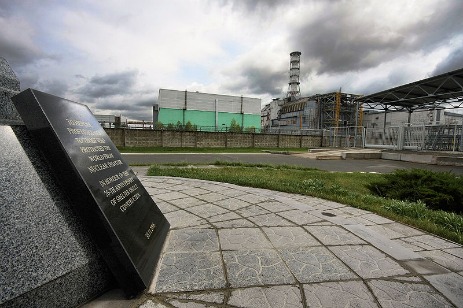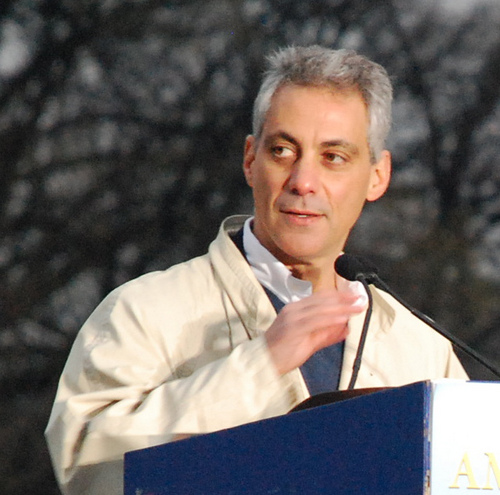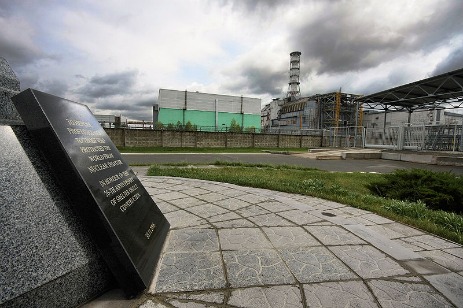 A memorial rests in the shadow of the Chernobyl nuclear plant.Photo: Matti PaavonenThis piece was written by John Perlin.
A memorial rests in the shadow of the Chernobyl nuclear plant.Photo: Matti PaavonenThis piece was written by John Perlin.
As a visiting scholar last year at the Linz Institute for Organic Solar Cells, I met Valery N. Bliznyuk, a visiting professor at Linz and a permanent faculty member at Western Michigan University. His fascinating work in materials at molecular and nanotech levels includes work on polymer photovoltaics.
Over dinner, he told me he hailed from Kiev (or Kyiv in Ukrainian), and the subject of Chernobyl inevitably arose. And now, with the disaster at Fukushima dredging up memories of that meltdown 25 years ago, Bliznyuk’s recollections of being a scientist laboring in an informational black hole seemed particularly resonant.
Yes, he told me, as a young physicist he had lived through the 1986 disaster at the Ukrainian nuclear plant about 60 miles north of his hometown.
Bliznyuk’s personal knowledge of Chernobyl began in the most banal way. He first learned of the world’s greatest nuclear power disaster from a routine news broadcast, not a breaking bulletin. As part of the same nightly newscast on April 26, 1986, two dispassionate sentences announced, “A fire has broken out at the Chernobyl Nuclear Power Station. The situation is under control.”
More bits of information emerged slowly. Several days into the crisis, the Voice of America (VOA) — this was during the era of the Soviet Union, and VOA offered an important outside source of news — reported that radioactivity had escaped, but the winds blowing southeast to northwest had carried all the nuclear debris toward Scandinavia. Meanwhile, the Soviet media admitted that though fires continued to rage, “All measures to keep it under control are being taken.”
Four days into the crisis, Bliznyuk and his colleagues showed up for their traditional May Day barbecue bash. At that point in the Soviet Union, most of the revolutionary stuff associated with the day had given way for an excuse to pig out and drink. And party Bliznyuk and his comrades did, they cooked shish-kebabs over an open fire, guzzled booze, and got wild as a rock ‘n’ roll band played. They were happy they hadn’t heeded the warning of a grumpy geologist friend who had called each of them earlier that day.
“Don’t go to the barbecue,” he warned. “Stay indoors. I can’t tell you what’s wrong. But don’t go outside.” As Bliznyuk remarked to me a quarter century later, his uptight colleague had “some secret only known to the Geological Society. But I was young at the time. I had prepared for the [barbecue] over many months. So I went, and I had a great time.”
The following day another ominous call came from an older friend and colleague. “I can’t tell you what is happening, but I’m on a team deactivating an awful mess. Stay at home. Don’t buy anything at the market. Close all your windows. And, by the way, your clothes reek with radiation.”
Everyone who had gone to the picnic got a similar call, and everyone was scared witless.
Bliznyuk reacted as a physicist. He went straight to the lab, took off the clothes and shoes he had worn the day before and checked them out with a Geiger counter. “Damn!” He recalled. “I had never seen such high readings.” He reconstructed what was going on from the calls and news reports and the mega dose of radioactivity he had just measured, coming to the conclusion something bad had happened at Chernobyl.
The masses — those without knowledgeable colleagues or access to Geiger counters, those who were assured by their masters that “everything was under control” — continued life as usual, having no way of knowing about the serious amount of nuclear poison they were ingesting in the foods they ate and the liquids they drank, or what was falling on their bodies every time they stepped outside and entering their lungs every time they breathed.
Slowly, word came through the public’s grapevine that something was just not right. Because the radiation was so great at the melted reactor, the cleanup cycled through lots of workers who quickly received the maximum — and beyond — safe dose and had to move on. When these workers returned from the front lines of this battle of Chernobyl, tongues wagged. Soon, millions knew about the nuclear disaster even with the Soviet broadcasts droning on about the valiant measures that “kept things under control.”
A great exodus began in early May from Kiev, although the radiation pattern — and areas evacuated — were concentrated north of the plant, in Belarus. Between that month and June, the women and children of Kiev left. The city transformed into a town of men careful to avoid vegetables and fruits picked after April 26 or meat from animals slaughtered during the same time frame. “You tried to eat only things produced before the catastrophe or if they passed muster under a Geiger counter,” Bliznyuk explained.
A forest behind the plant was dubbed the Red Forest (perhaps with an additional touch intentional irony given the official stonewalling) after radiation cooked the trees and turned them a ginger color. The forest was bulldozed and buried in impermeable shrouds.
Bliznyuk said many more died than either the Soviets or the international community admitted (a point still the focus of a lively debate between those who say the count was lower than first estimated and those who insist it must be higher.
But the psychological toll overshadowed everything else. When might cancer strike? Pregnant women stressed over deformities their babies might develop. Everyone lost any lingering trust in the Soviet system, and respect for science and scientists was greatly diminished.
Only when they had buried the remains of the destroyed reactor under the sarcophagus of cement, Bliznyuk said, did the women and children return. The Chernobyl area and the town of Pripyat remain vacant except for those studying the devastation. Perhaps surprisingly, the undamaged portions of the plant remained active until 2000, shut down only after Ukraine convinced the rest of Europe and the U.S. into paying for a “New Safe Confinement and Spent Fuel Storage Facility” [PDF] for the destroyed reactor and its fuel rods.
For Bliznyuk, Chernobyl greatly changed his views on energy generation: “Solar power has a bright future. Not so for nuclear,” he said, well before Japan’s current nightmare.
This article was syndicated with permission from Miller-McCune, an online and print magazine that focuses on practical options for solving serious problems, particularly if the options are backed by quality research and evidence.



